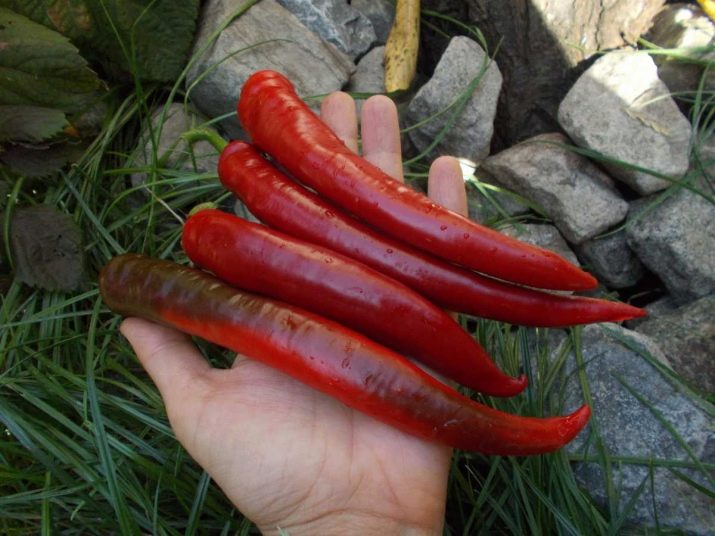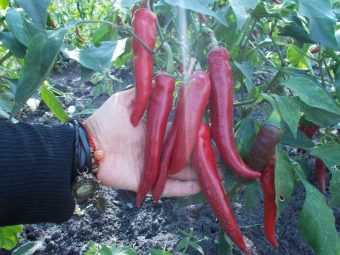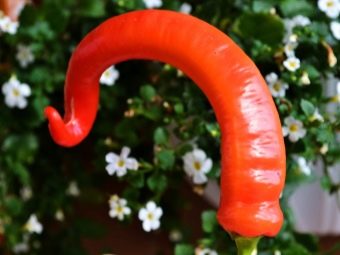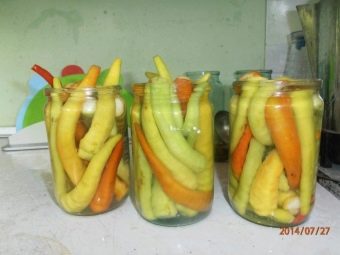Pepper "Mutton horn": features of the variety and cultivation
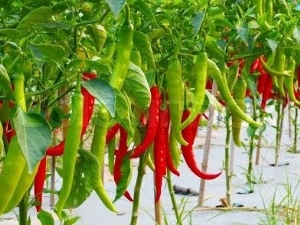
Pepper "Mutton horn" is one of 1500 varieties of Bulgarian pepper, more precisely, its bitter variety. This type of peppers will appeal to lovers of spicy and burning food.The advantage of this pepper is that it can be eaten raw, for example, by making a sandwich or cutting it into a salad. When consumed, burning spicyness quickly dies away and a pleasant savory aftertaste remains on the tongue. To grow this culture, the gardener will have to make a lot of effort, since this type of pepper is considered very whimsical and demanding.
Characteristic
Variety bred in Italy, the work of breeders dates back to the beginning of the XX century. "Mutton horn" - a very fruitful culture, subject to all the rules of agricultural technology. The height of the bushes varies from 50 to 100 cm. The width reaches 65 cm in volume. The bush is covered with foliage of light green color and is almost completely covered with fruits of green and red flowers, 15-25 cm long. The number of ripe peppers that can be removed from the bush reaches 60 pieces, and the total weight of this crop is about 1.9 kg.
The tips of the fruit are curved to the shape of the ram's horns, hence its name. To taste, pepper is medium sharp, much softer than its “brother” - hot red chili pepper. Therefore, "Mutton horn" can be used by people who monitor the condition of their stomach. The plant will not harm the mucous membrane when used in reasonable quantities. Reviews of this variety are mostly only positive.
How to grow yourself
As already mentioned, culture requires increased attention. Therefore, to approach the cultivation should be with all care and care. We start with the selection of seeds. You can buy them on the market and in specialized stores at an affordable price. At home, pour the seeds on a piece of paper and begin the inspection. They should be yellowish, the same thickness and not have a dark patina, which will mean that the planting material is healthy and during storage is not rotting.
Next step: pour water into the bowl and pour our seed there. If all the seeds drowned, then we are lucky, we bought a quality product. Pop-up copies need to be thrown away, there will be no sense from them, they are empty. Germinate seeds in the middle lane of our country begin in April in order to plant seedlings in a greenhouse in May. There are several ways to germinate. Choose the one where the fabric is used. Need a cotton flap, about 20 × 20 cm.
The fabric should be well moistened in boiled water. A little shy of insurance to avoid seed infection. To do this, we pre-soak them in a solution of potassium permanganate for 1 hour. Then lay them on the prepared rag, which can be put in a flat plate. Cover with the free end of the flap. We put a dish with seeds on a window sill.
Sprouting seeds should be practiced in a room with a temperature of 20-25 degrees Celsius.
Every day from a spray bottle is to spray the seeds with water so as not to dry them. The first sprout will appear in 7-10 days. Sometimes germination can be delayed up to 14 days, you should not worry. The root appears first, followed by the first leaf coming out of the cotyledon. The appearance of the leaflet serves as an indicator for planting in pots for growing seedlings. After 10-14 days we plant seedlings in trays or pots for seedlings. If you choose large trays for seedlings, you will need to monitor soil moisture more carefully. Both the excess of moisture and its deficiency are detrimental.
Watering should be carried out using a small watering can, water pours not jetting, but drip technology. Preferably for growing seedlings take peat cups, fill them with soil. It can be purchased at a hardware or flower shop. On the package should be the inscription "To grow peppers" or "Universal" soil. Make a recess in the middle with a pencil to a depth of 1.5 cm and carefully place a seed with a germ there. Sprinkle with earth and lightly crush. We leave on the windowsill, so that there is enough sunlight.
The seedling is demanding to the light, it needs a light day of 12-14 hours. Therefore, in the place where we grow peppers, we install additional lighting in the form of fluorescent lamps. Growth seedlings will last more than a month. We conduct top dressing once a week and for this we use complex fertilizers. It is recommended to use "Superphosphate" in combination with urea (30 g of superphosphate + 7 g of urea + 10 l of water). It is considered an ideal fertilizer for sprout growth. During their growth fertilizer will be applied 4 times.
We make sure that the soil does not dry out and was not overmoistened. More frequent use of fertilizers is not recommended, because as a result we will get long and frail plants. We need to achieve a strong root system, thick legs and strong foliage. After the appearance of leaflets, the temperature of the surrounding air is recommended to be reduced to 18 degrees or slightly lower. It is also recommended to open the window or to take out seedlings in a cooler room. In this case, natural hardening of the plants will occur, which will have a positive effect on the yield in the future.
When sprouts reach a height of 15-20 cm, you can plant seedlings in open ground. There are two options: landing in the open on the prepared beds or landing in the greenhouse. If we choose a greenhouse, then we can be sure that the crop is insured against the vagaries of nature: a rainy summer and a scorching sun. The soil for our plants requires a light fertile, preferably loamy.
Nitrogen fertilizers are recommended before planting.
It is advisable to plant peppers in the place where they grew peas, beans or cabbage last year. At this point there should be no stagnation of water, so the drainage system should work properly. We start landing. When choosing the natural conditions of growth, that is, the usual beds, it is necessary to prepare the ground for planting. Well dig up, ground the earth. Add nitrogen and phosphate fertilizers. We make a breakdown of the beds using a cord and pegs to form rows.
The root system of the Mutton Horn pepper is very delicate, so the peat cups are well spilled with water and carefully remove the plants, trying not to damage the roots. Diving here is not good, it can weaken the culture. We do not shake off the earth from the roots, we make the landing with that lump, like he was in the pot. Optimal landing in the ground at a distance of 60 cm from each other, given the width of the bushes.
We plant the plants in a staggered manner, making the distance between the rows of 30 cm. Such a planting procedure is considered ideal for care, and the distance will allow to care for the bushes without causing them harm. Pepper planting usually occurs in mid-May. Since the whole vegetation period takes 140-160 days, summer residents will have time to harvest peppers already in summer. The first fruits can be removed in July, and fruiting ends in late September.
Care after landing in the ground
It consists in weeding and timely loosening the soil, avoiding stagnant water. Reception of experienced gardeners: in the evening they watered the soil, in the morning they rowed through the rows. This method will help not to form an earth crust and will facilitate proper gas exchange in the earth layer. To reduce weeding will allow mulching of the soil under the bushes. As mulch you can use mowed grass, hay and foliage of trees. Mulching will help preserve moisture in the soil, and weeds without the presence of sunlight will grow in limited quantities.
Care also consists in regular and abundant watering at the very root. Top dressing is carried out once before planting with slowly absorbing fertilizers. You can recommend the composition of "Kemira-Lux". If necessary, which will show the appearance of plants, feeding can be duplicated after a week and a half.
Fertilizers containing chlorine are not recommended for feeding peppers, as they have a bad effect on both growth and fruiting.
Pests
The main pests that can spoil the crop are aphid, bare slugs, black leg, spider mite. A fungal infection is also common. Treatment against pests produced before and immediately after flowering plants. For the destruction of pests recommended the use of "karbofos". For the destruction of aphids during the tying of fruits use solutions of ash and tobacco. Spider mite can be destroyed with onion juice. When the disease is fungus, the plants are uprooted and burned, no longer planting at this place.
Harvesting and storage of the crop
At this point, the care for pepper after planting can be considered finished. Harvesting can be carried out gradually as the fruit ripens. Maturity is determined by appearance: the length of the fetus, color and thickness (1-1.5 mm).
Pepper is carefully removed, unscrewing from the stem, while trying not to damage the plant itself and giving it the opportunity to bear fruit until the last ripening period.
The next task is to preserve the harvest. Removing peppers, put them in a cool room in wooden boxes, sprinkling layers of chips. A cellar or cellar is suitable for such storage. But this method will save pepper only for a month. A small amount can be cut into rings and freeze, using later for cooking hot dishes. The aroma and taste of the vegetable will not be lost. But the main method of storage for the winter, of course, is conservation. Sugar, salt and vinegar will help unleash the full taste of this product.
To learn how to cook a sharp pickled pepper "Mutton horn" for the winter, see the next video.

